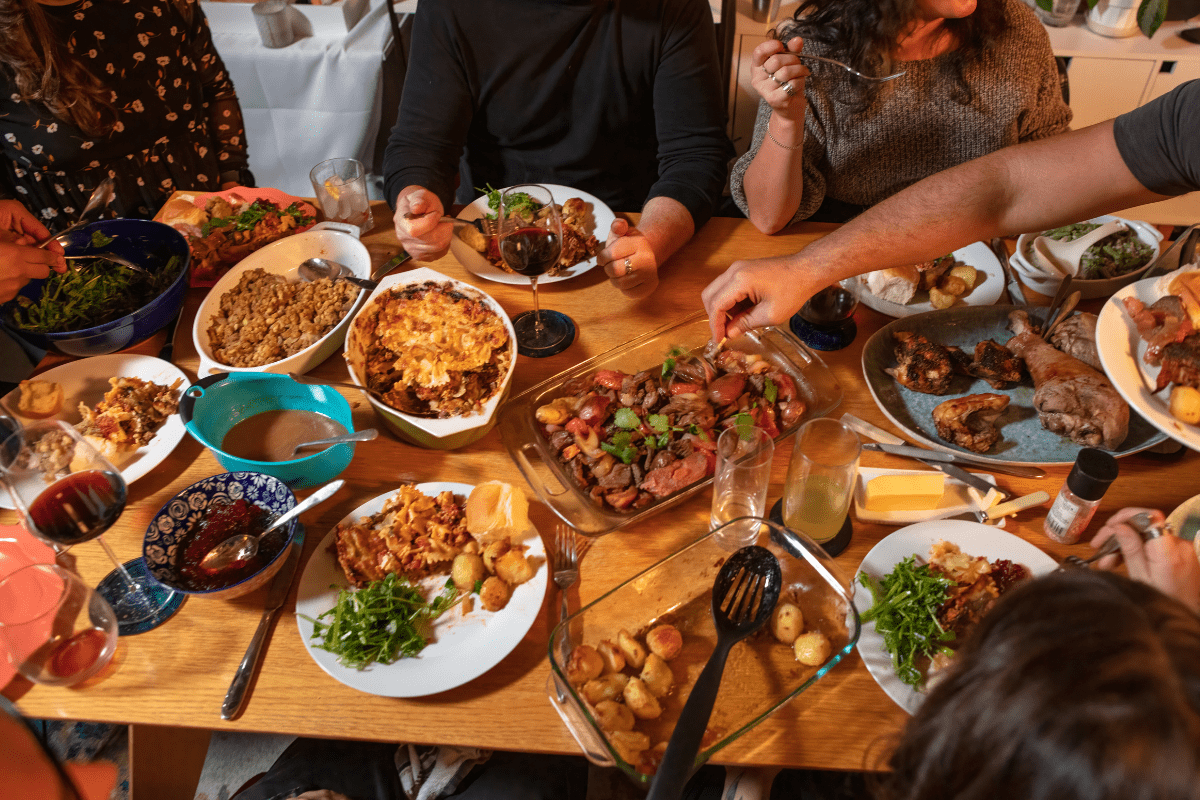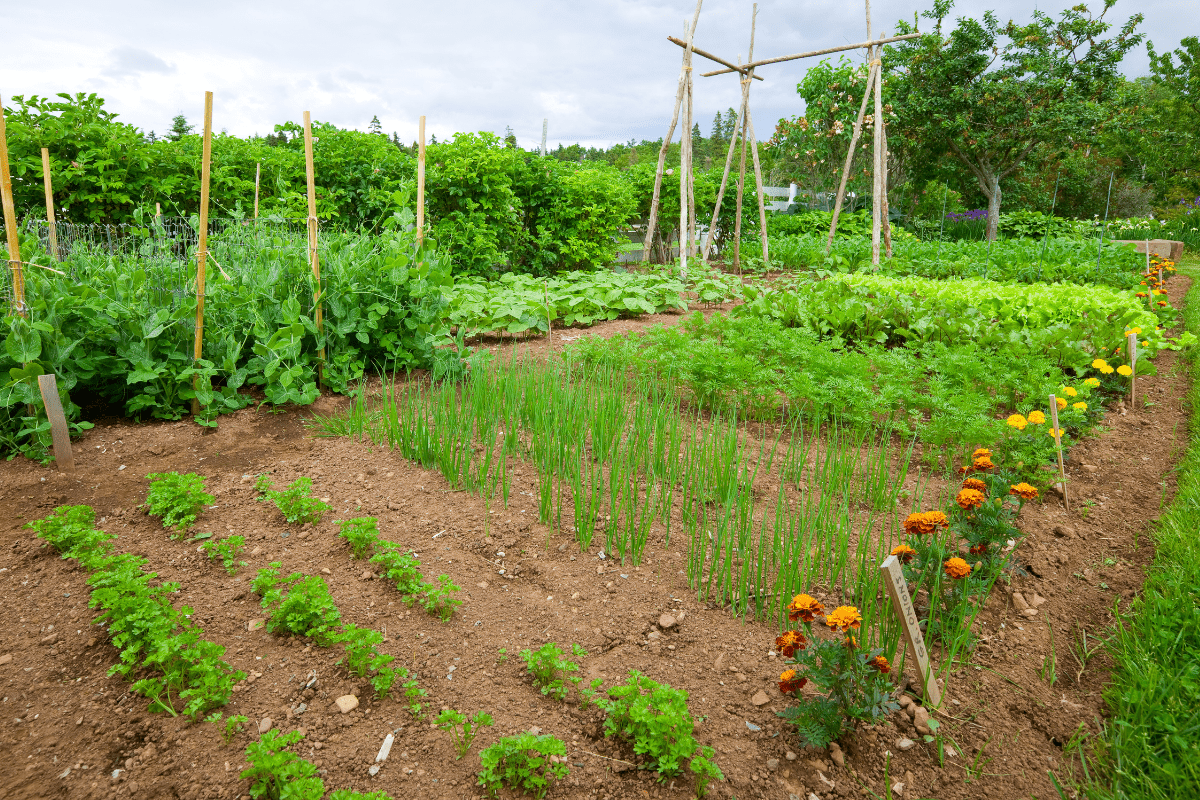Oregon might be famous for rain and flannel, but locals know the real draw is the food scene that puts other states to shame. While everyone else argues about pizza styles, Oregonians are quietly producing 99% of America's hazelnuts and turning food carts into a legitimate art form.
The dishes that actually define Oregon
Let's start with the heavy hitters that make Oregon special. These aren't just tourist traps; they're the foods that locals get genuinely excited about.
Marionberries: The berry that rules them all
The marionberry isn't just Oregon's state berry – it's basically berry royalty. Developed in 1956 at Oregon State University, this deep purple beauty was named after Marion County and grows almost nowhere else. Locals call it the "Cabernet of blackberries," which sounds pretentious until you taste one.
Traditional marionberry pie keeps things simple: fresh berries, minimal sugar, some cornstarch, and a flaky butter crust. That's it. No need to mess with perfection. But if you want to see what happens when chefs get creative, head to Le Pigeon (738 E Burnside St, Portland) where they glaze meats with marionberry sauce. Yes, it works. Or swing by any Salt & Straw location for their marionberry ice cream that'll ruin you for all other ice cream flavors.
The Oregon Berry Festival celebrates these beauties every summer, and yes, there are pie-eating contests. Because Oregon.
Cedar plank salmon: 10,000 years of delicious
Before Portland was putting birds on things, Columbia River tribes were perfecting salmon preparation for literally thousands of years. Cedar plank salmon isn't some trendy restaurant invention – it's evolved from traditional methods using alder or cedar spits that Native peoples have used forever.
The salmon holds serious cultural weight too. It's one of the five "First Foods" in tribal ceremonies, alongside game, roots, berries, and pure water. Traditional preparations include wind-dried salmon and salmon jerky, which taste way better than they sound.
Want the real deal? Brigham Fish Market continues these traditional preparations without the fancy restaurant markup. But if you're feeling fancy, pretty much every Oregon restaurant worth its salt (or should I say, cedar?) offers their take on plank salmon with seasonal vegetables.
Dungeness crab: Newport's claim to fame
Newport proudly calls itself the "Dungeness crab capital" of the world, and with 16 million pounds harvested annually, they've earned the bragging rights. Peak season runs December through February, when the crab is sweetest and restaurants along the coast go absolutely nuts with crab specials.
Here's where to get your crab fix:
- Clearwater Restaurant (325 SW Bay Blvd, Newport)
- Georgie's Beachside Grill (744 SW Elizabeth St, Newport)
- Restaurant Beck (2345 US-101, Depoe Bay)
- The Wayfarer Restaurant (1190 Pacific Drive, Cannon Beach)
Pro tip: Georgie's claims to have the coast's best clam chowder, and after extensive "research," I'm not arguing.
The mighty Oregon hazelnut
Here's a fun fact to drop at parties: Oregon produces 99% of US hazelnuts. That's 45,000 acres and 800+ family farms cranking out $38.5 million worth of nuts annually. The Willamette Valley's climate is basically hazelnut heaven.
Traditional uses keep it simple – hazelnut shortbread, toffee, and increasingly, hazelnut pesto (way cheaper than pine nuts, just saying). For the fancy treatment, Joel Palmer House in Dayton showcases hazelnuts alongside their famous wild mushroom dishes. It's the kind of place where you pretend to understand wine pairings while secretly just wanting more bread.
Don't miss the fall hazelnut festivals in Donald and Mt. Angel if you're really committed to the nut life.
Wait, Oregon invented WHAT?
Prepare to have your mind blown. Oregon invented tater tots in 1953 when the Grigg brothers at their Ore-Ida plant needed something to do with potato scraps. You're welcome, America.
The Pronto Pup originated in the 1930s at Rockaway Beach when rain ruined some hamburger buns, leading to the pancake-batter coating we know and love. The original still operates at 602 S. Highway 101 if you want to make a pilgrimage.
And the Gardenburger was created in 1981 at a Gresham restaurant, decades before plant-based meat became trendy. Oregon: accidentally ahead of the curve since forever.
Portland's food cart empire
Portland has turned street food into high art with 500+ food carts scattered across the city. The genius move was clustering them into "pods" – basically food courts without the mall.
How the cart system actually works
Unlike other cities where food trucks appear randomly like rare Pokemon, Portland carts stay put in pods with actual addresses. Most accept both cash and cards (though cash is still king at some spots). Prices typically run $8-15 per person, which beats any sit-down restaurant for quality-to-cost ratio.
Cart etiquette for newbies:
- Order from each cart individually
- Share the communal seating
- Bus your own table
- Don't be that person hogging seats
- Tip well (these folks work hard)
The pods you need to know
Cartopia at 1207 SE Hawthorne started the whole pod revolution and remains the late-night champion. Fire pits, covered seating, and carts open until 3 AM on weekends make it a drunk food paradise. Potato Champion serves Belgian fries with poutine options that'll change your life, while Pyro Pizza somehow fits a wood-burning brick oven on a trailer.
Hawthorne Asylum (1080 SE Madison) brings the variety with 20+ carts and an actual beer garden. Chicken and Guns does wood-fired Latin chicken that'll make you question every rotisserie chicken you've ever had. BKK Pad Thai keeps it real with authentic Thai that doesn't dumb down the spice levels.
Regional food adventures beyond Portland
Portland gets all the press, but Oregon's best eating requires some road tripping.
Coastal dining: More than just views
The Oregon coast offers 362 miles of seafood paradise, with restaurants timing their menus to what's literally swimming by that week. Storm season (October-March) creates the most dramatic dining experiences – nothing beats eating crab while watching 20-foot waves crash outside.
Seasonal coastal guide:
- Winter: Peak Dungeness crab
- Spring: Early salmon runs
- Summer: Halibut and albacore tuna
- Fall: Perfect oyster conditions
Traditional cooking methods rule here – cedar plank grilling, Native American smoking techniques, and clam chowders so rich your cardiologist would faint. Every restaurant claims theirs is the best, and honestly, they might all be right.
Wine country: Where Pinot dreams come true
The Willamette Valley's 700+ wineries follow the "what grows together, goes together" philosophy. Oregon wine law requires 90% varietal content versus 75% nationally, which explains why Oregon Pinot started beating French wines in blind tastings back in the 1980s.
Joel Palmer House holds 550+ Oregon Pinot Noirs from 175 wineries, earning Wine Spectator awards while serving wild mushroom and truffle dishes in an 1857 building. It's fancy, but approachably fancy – like wearing sneakers with your suit.
Seasonal wine country eating follows the harvest: spring asparagus with morels, summer berries drowning in cream, fall chanterelles with everything, and winter root vegetables braised in more wine than strictly necessary.
The money side of eating well
Oregon's food scene isn't just delicious – it's an economic powerhouse employing 531,000 people and generating $42 billion annually. The restaurant industry alone supports 167,700 workers across 9,000 locations, capturing 54% of tourism dollars.
Behind it all: 225 different agricultural commodities with 95% of farmland still family-held. Add 300+ breweries (Portland has the most per capita of any major US city) and 200+ coffee roasters, and you've got a state that takes its beverages as seriously as its food.
Actually useful dining tips
Here's the insider knowledge that'll save you from hangry waiting:
Timing is everything
Peak dinner rush hits 7-9 PM on weekends. Show up at 6 PM or after 9 PM for shorter waits. Many Portland spots close Mondays (industry night is Sunday, hence the hangovers). Tuesday through Thursday offers the best spontaneous dining odds.
Hot restaurants like Kann or Langbaan need reservations 2-3 weeks out, but most places save bar seats for walk-ins. Pro move: eat at the bar anyway for better service and chef watching.
What you'll actually spend
Real talk on prices:
- Food carts: $8-15
- Casual spots: $15-25
- Mid-range restaurants: $25-40
- Fancy dinner with wine: $75-125
- Tasting menus: $65-100
Han Oak's $65 tasting menu and Ariana's $100 spread offer stupid good value for the quality. Compare that to other cities' tasting menus and cry tears of joy.
Dietary restrictions? No problem
Oregon restaurants excel at accommodations. Vegetarian, vegan, and gluten-free options come standard almost everywhere. Gregory Gourdet's Kann runs entirely dairy and gluten-free while serving Haitian food that'll knock your socks off.
Festivals for serious eaters
Oregon knows how to throw a food party. The Portland Seafood & Wine Festival in March draws 15,000+ people to sample from 90+ vendors. Newport's February seafood fest celebrates peak crab season with the enthusiasm it deserves.
Beer lovers mark your calendars:
- Oregon Brewers Festival (May)
- Mount Angel Oktoberfest (September)
- 350,000+ attendees can't be wrong
The Latino Cultural Festival in Hillsboro (June 22, 2025) and Marianas Festival in Fairview (August 22-24, 2025) bring international flavors with the kind of authenticity you won't find at food trucks run by guys named Brad.
The chefs making it happen
Oregon's James Beard Award winners aren't just collecting accolades – they're reshaping what Pacific Northwest cuisine means. Gregory Gourdet describes his Kann (2713 SE Ankeny) as having "its own food language" with Haitian flavors meeting Oregon ingredients.
Gabriel Rucker evolved from self-described "25-year-old gastrobasher" to two-time winner at Le Pigeon. Sarah Minnick at Lovely's Fifty Fifty literally forages Forest Park for pizza toppings because of course she does. This is Portland.
What's next for Oregon food
The future looks delicious and slightly weird, in true Oregon fashion. Ghost kitchens expand delivery options while hyper-local sourcing shrinks to 25-mile radiuses. Pop-ups graduate to permanent spots faster than ever. Korean-American fusion and Southeast Asian flavors dominate the newest openings.
Post-pandemic changes stuck around: outdoor seating everywhere, QR menus (RIP physical menus), and takeout that doesn't suck. Through it all, Oregon maintains its core values – supporting family farms, celebrating local ingredients, and making sure everyone can eat well regardless of dietary needs.
From Dungeness crab on the coast to food carts in Portland, from hazelnut orchards to Pinot vineyards, Oregon offers a uniquely American food adventure. It's unpretentious but excellent, traditional yet innovative, and always rooted in the incredible bounty of the Pacific Northwest. Come hungry, leave happy, and maybe pick up some tater tots on your way out. You know, for history's sake.





